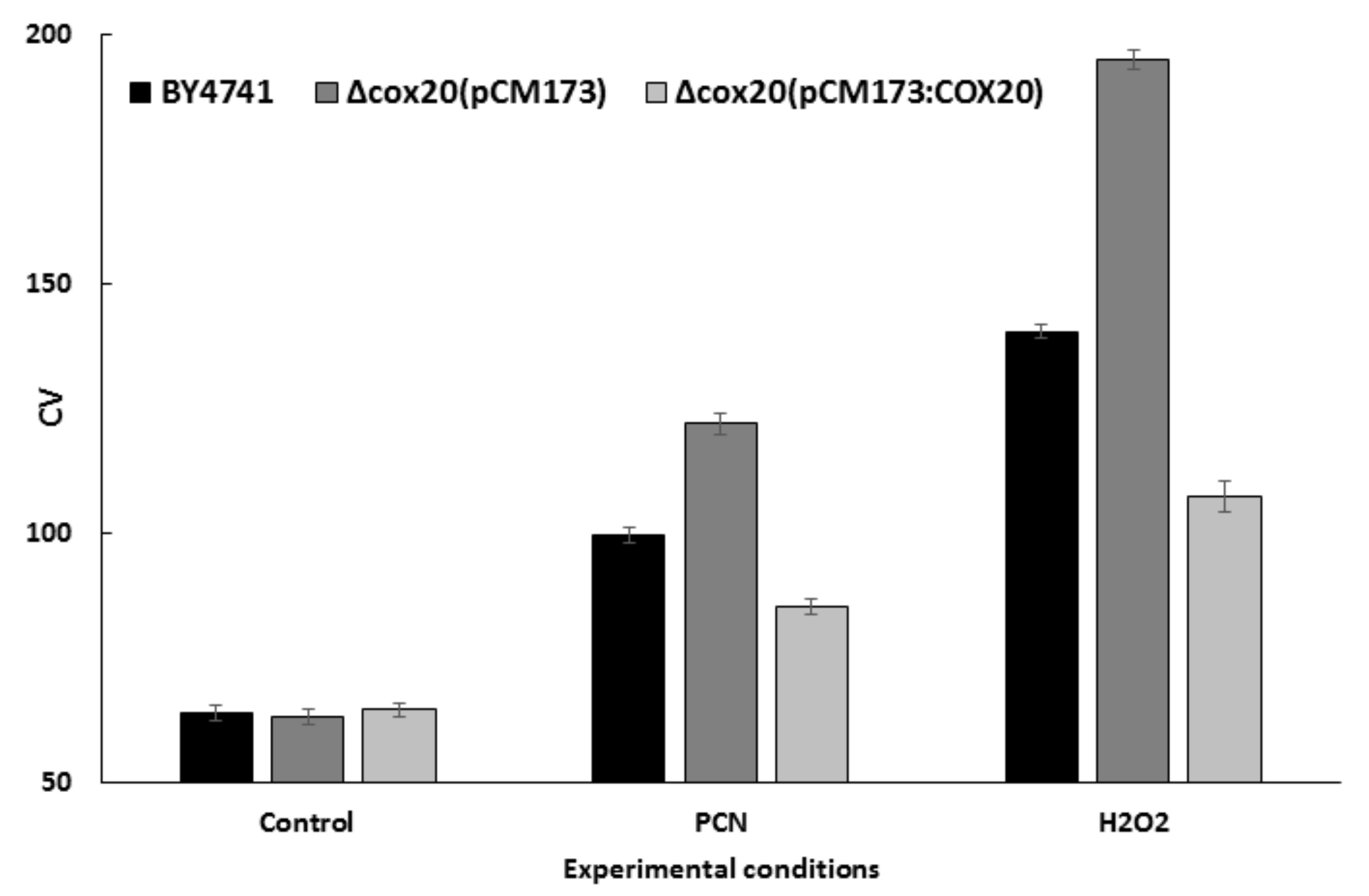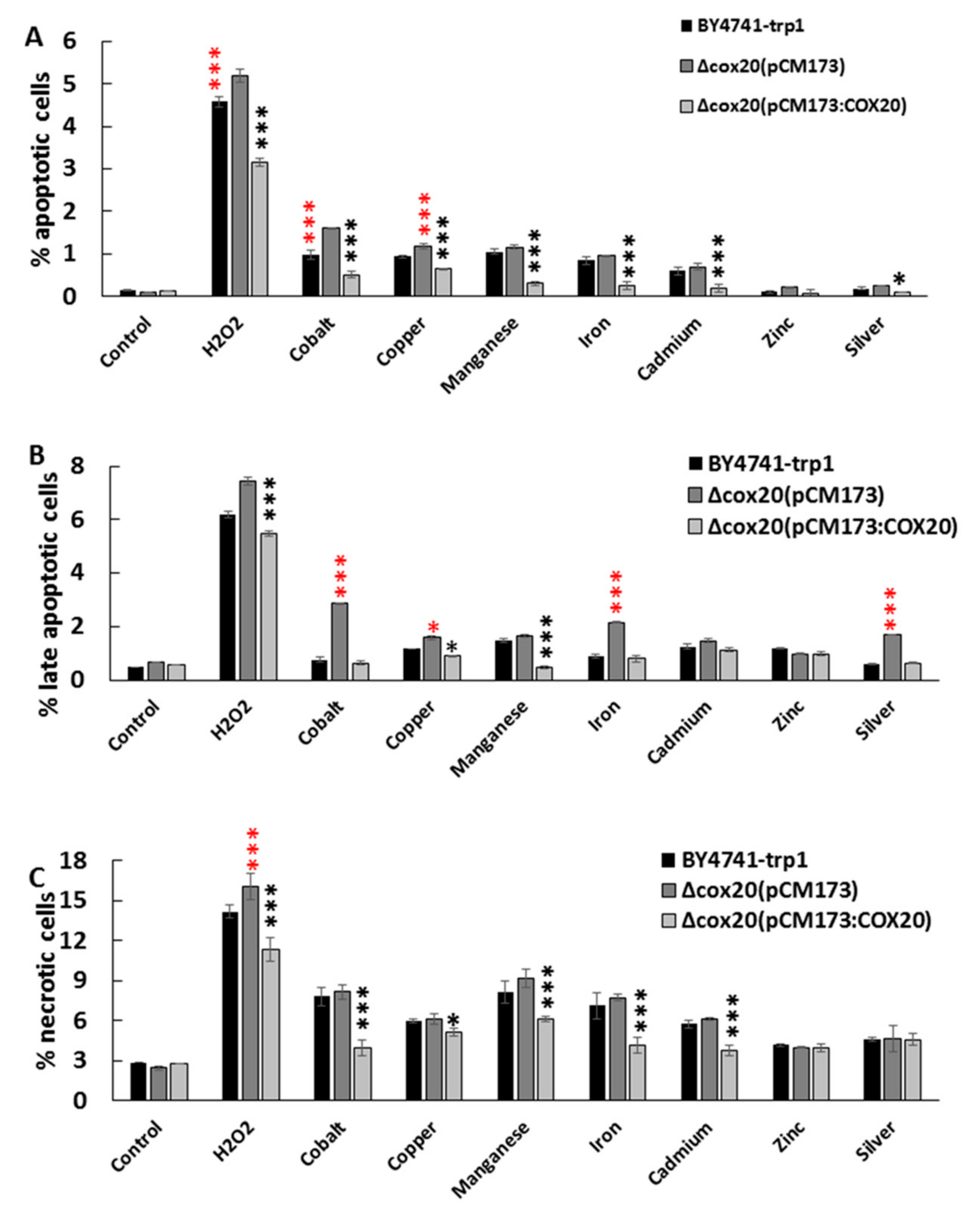A Role for COX20 in Tolerance to Oxidative Stress and Programmed Cell Death in Saccharomyces cerevisiae
Abstract
1. Introduction
2. Material and Methods
2.1. Strains, Media, and Growth Conditions
2.2. Spot Plate Assays
2.3. Determination of GSH and GSSG Levels
2.4. ROS Detection Kit
2.5. Cell Preparation for Flow Cytometry
2.6. Statistics
3. Results
3.1. Overexpression of COX20 Protects Yeast Cells from Oxidative Stress
3.2. COX20 Overexpression Protects the Cell from Glutathione Becoming Oxidized
3.3. Overexpression of COX20 Reduced the Presence of Apoptotic, Late Apoptotic, and Necrotic Yeast Cells
3.4. Investigating the Role of COX20 in the Mitochondrial Response to Oxidative Stress
4. Discussion
Author Contributions
Funding
Conflicts of Interest
References
- Gibson, B.R.; Lawrence, S.J.; Leclaire, J.P.; Powell, C.D.; Smart, K.A. Yeast responses to stresses associated with industrial brewery handling. FEMS Microbiol. Rev. 2007, 31, 535–569. [Google Scholar] [CrossRef]
- Verbelen, P.J.; Saerens, S.M.; Van Mulders, S.E.; Delvaux, F.; Delvaux, F.R. The role of oxygen in yeast metabolism during high cell density brewery fermentations. Appl. Microbiol. Biotechnol. 2009, 82, 1143–1156. [Google Scholar] [CrossRef]
- Lorenz, R.T.; Parks, L.W. Involvement of heme components in sterol metabolism of Saccharomyces cerevisiae. Lipids 1991, 26, 598–603. [Google Scholar] [CrossRef] [PubMed]
- Gutteridge, J.M.; Halliwell, B. The measurement and mechanism of lipid peroxidation in biological systems. Trends Biochem. Sci. 1990, 15, 129–135. [Google Scholar] [CrossRef]
- Vivancos, A.P.; Jara, M.; Zuin, A.; Sanso, M.; Hidalgo, E. Oxidative stress in Schizosaccharomyces pombe: Different H2O2 levels, different response pathways. Mol. Genet. Genom. 2006, 276, 495–502. [Google Scholar] [CrossRef] [PubMed]
- Yang, M.H.; Schaich, K.M. Factors affecting DNA damage caused by lipid hydroperoxides and aldehydes. Free Radic. Biol. Med. 1996, 20, 225–236. [Google Scholar] [CrossRef]
- Drakulic, T.; Temple, M.D.; Guido, R.; Jarolim, S.; Breitenbach, M.; Attfield, P.V.; Dawes, I.W. Involvement of oxidative stress response genes in redox homeostasis, the level of reactive oxygen species, and ageing in Saccharomyces cerevisiae. FEMS Yeast Res. 2005, 5, 1215–1228. [Google Scholar] [CrossRef]
- Barker, M.G.; Walmsley, R.M. Replicative ageing in the fission yeast Schizosaccharomyces pombe. Yeast 1999, 15, 1511–1518. [Google Scholar] [CrossRef]
- Van Zandycke, S.M.; Sohier, P.J.; Smart, K.A. The impact of catalase expression on the replicative lifespan of Saccharomyces cerevisiae. Mech. Ageing Dev. 2002, 123, 365–373. [Google Scholar] [CrossRef]
- Lee, J.; Spector, D.; Godon, C.; Labarre, J.; Toledano, M.B. A new antioxidant with alkyl hydroperoxide defense properties in yeast. J. Biol. Chem. 1999, 274, 4537–4544. [Google Scholar] [CrossRef]
- Trotter, E.W.; Grant, C.M. Overlapping roles of the cytoplasmic and mitochondrial redox regulatory systems in the yeast Saccharomyces cerevisiae. Eukaryot. Cell 2005, 4, 392–400. [Google Scholar] [CrossRef] [PubMed]
- Grant, C.M.; MacIver, F.H.; Dawes, I.W. Glutathione is an essential metabolite required for resistance to oxidative stress in the yeast Saccharomyces cerevisiae. Curr. Genet. 1996, 29, 511–515. [Google Scholar] [CrossRef] [PubMed]
- Hell, K.; Tzagoloff, A.; Neupert, W.; Stuart, R.A. Identification of Cox20p, a novel protein involved in the maturation and assembly of cytochrome oxidase subunit 2. J. Biol. Chem. 2000, 275, 4571–4578. [Google Scholar] [CrossRef] [PubMed]
- Elliott, L.E.; Saracco, S.A.; Fox, T.D. Multiple roles of the Cox20 chaperone in assembly of Saccharomyces cerevisiae cytochrome c oxidase. Genetics 2012, 190, 559–567. [Google Scholar] [CrossRef]
- Kumar, V.; Hart, A.J.; Keerthiraju, E.R.; Waldron, P.R.; Tucker, G.A.; Greetham, D. Expression of Mitochondrial Cytochrome C Oxidase Chaperone Gene (COX20) Improves Tolerance to Weak Acid and Oxidative Stress during Yeast Fermentation. PLoS ONE 2015, 10, e0139129. [Google Scholar] [CrossRef]
- Barakat, R.; Goubet, I.; Manon, S.; Berges, T.; Rosenfeld, E. Unsuspected pyocyanin effect in yeast under anaerobiosis. Microbiologyopen 2014, 3, 1–14. [Google Scholar] [CrossRef]
- Aluru, S.V.; Agarwal, S.; Srinivasan, B.; Iyer, G.K.; Rajappa, S.M.; Tatu, U.; Padmanabhan, P.; Subramanian, N.; Narayanasamy, A. Lacrimal proline rich 4 (LPRR4) protein in the tear fluid is a potential biomarker of dry eye syndrome. PLoS ONE 2012, 7, e51979. [Google Scholar] [CrossRef]
- Ercal, N.; Gurer-Orhan, H.; Aykin-Burns, N. Toxic metals and oxidative stress part I: Mechanisms involved in metal-induced oxidative damage. Curr. Top. Med. Chem. 2001, 1, 529–539. [Google Scholar] [CrossRef]
- Madeo, F.; Frohlich, E.; Ligr, M.; Grey, M.; Sigrist, S.J.; Wolf, D.H.; Frohlich, K.U. Oxygen stress: A regulator of apoptosis in yeast. J. Cell Biol. 1999, 145, 757–767. [Google Scholar] [CrossRef]
- Bonnefoy, N.; Fiumera, H.L.; Dujardin, G.; Fox, T.D. Roles of Oxa1-related inner-membrane translocases in assembly of respiratory chain complexes. Biochim. Biophys. Acta 2009, 1793, 60–70. [Google Scholar] [CrossRef]
- Lorenzi, I.; Oeljeklaus, S.; Ronsor, C.; Bareth, B.; Warscheid, B.; Rehling, P.; Dennerlein, S. Ribosome-Associated Mba1 Escorts Cox2 from Insertion Machinery to Maturing Assembly Intermediates. Mol. Cell. Biol. 2016, 36, 2782–2793. [Google Scholar] [CrossRef] [PubMed]
- Izawa, S.; Inoue, Y.; Kimura, A. Oxidative stress response in yeast: Effect of glutathione on adaptation to hydrogen peroxide stress in Saccharomyces cerevisiae. FEBS Lett. 1995, 368, 73–76. [Google Scholar] [CrossRef]
- Ludovico, P.; Madeo, F.; Silva, M. Yeast programmed cell death: An intricate puzzle. IUBMB Life 2005, 57, 129–135. [Google Scholar] [CrossRef] [PubMed][Green Version]
- Guaragnella, N.; Passarella, S.; Marra, E.; Giannattasio, S. Cytochrome c Trp65Ser substitution results in inhibition of acetic acid-induced programmed cell death in Saccharomyces cerevisiae. Mitochondrion 2011, 11, 987–991. [Google Scholar] [CrossRef]
- Giannattasio, S.; Atlante, A.; Antonacci, L.; Guaragnella, N.; Lattanzio, P.; Passarella, S.; Marra, E. Cytochrome c is released from coupled mitochondria of yeast en route to acetic acid-induced programmed cell death and can work as an electron donor and a ROS scavenger. FEBS Lett. 2008, 582, 1519–1525. [Google Scholar] [CrossRef] [PubMed]
- Mejia-Barajas, J.A.; Montoya-Perez, R.; Salgado-Garciglia, R.; Aguilera-Aguirre, L.; Cortes-Rojo, C.; Mejia-Zepeda, R.; Arellano-Plaza, M.; Saavedra-Molina, A. Oxidative stress and antioxidant response in a thermotolerant yeast. Braz. J. Microbiol. 2017, 48, 326–332. [Google Scholar] [CrossRef] [PubMed]
- Saita, E.A.; de Mendoza, D. Thermosensing via transmembrane protein-lipid interactions. Biochim. Biophys. Acta 2015, 1848, 1757–1764. [Google Scholar] [CrossRef]
- Landolfo, S.; Politi, H.; Angelozzi, D.; Mannazzu, I. ROS accumulation and oxidative damage to cell structures in Saccharomyces cerevisiae wine strains during fermentation of high-sugar-containing medium. Biochim. Biophys. Acta 2008, 1780, 892–898. [Google Scholar] [CrossRef]
- De Freitas, J.; Wintz, H.; Kim, J.H.; Poynton, H.; Fox, T.; Vulpe, C. Yeast, a model organism for iron and copper metabolism studies. Biometals 2003, 16, 185–197. [Google Scholar] [CrossRef]
- Valko, M.; Morris, H.; Cronin, M.T. Metals, toxicity and oxidative stress. Curr. Med. Chem. 2005, 12, 1161–1208. [Google Scholar] [CrossRef]
- Fiumera, H.L.; Dunham, M.J.; Saracco, S.A.; Butler, C.A.; Kelly, J.A.; Fox, T.D. Translocation and assembly of mitochondrially coded Saccharomyces cerevisiae cytochrome c oxidase subunit Cox2 by Oxa1 and Yme1 in the absence of Cox18. Genetics 2009, 182, 519–528. [Google Scholar] [CrossRef] [PubMed]
- Garcia, M.; Greetham, D.; Wimalasena, T.T.; Phister, T.G.; Cabellos, J.M.; Arroyo, T. The phenotypic characterization of yeast strains to stresses inherent to wine fermentation in warm climates. J. Appl. Microbiol. 2016, 121, 215–233. [Google Scholar] [CrossRef] [PubMed]






© 2019 by the authors. Licensee MDPI, Basel, Switzerland. This article is an open access article distributed under the terms and conditions of the Creative Commons Attribution (CC BY) license (http://creativecommons.org/licenses/by/4.0/).
Share and Cite
Keerthiraju, E.; Du, C.; Tucker, G.; Greetham, D. A Role for COX20 in Tolerance to Oxidative Stress and Programmed Cell Death in Saccharomyces cerevisiae. Microorganisms 2019, 7, 575. https://doi.org/10.3390/microorganisms7110575
Keerthiraju E, Du C, Tucker G, Greetham D. A Role for COX20 in Tolerance to Oxidative Stress and Programmed Cell Death in Saccharomyces cerevisiae. Microorganisms. 2019; 7(11):575. https://doi.org/10.3390/microorganisms7110575
Chicago/Turabian StyleKeerthiraju, Ethiraju, Chenyu Du, Gregory Tucker, and Darren Greetham. 2019. "A Role for COX20 in Tolerance to Oxidative Stress and Programmed Cell Death in Saccharomyces cerevisiae" Microorganisms 7, no. 11: 575. https://doi.org/10.3390/microorganisms7110575
APA StyleKeerthiraju, E., Du, C., Tucker, G., & Greetham, D. (2019). A Role for COX20 in Tolerance to Oxidative Stress and Programmed Cell Death in Saccharomyces cerevisiae. Microorganisms, 7(11), 575. https://doi.org/10.3390/microorganisms7110575





